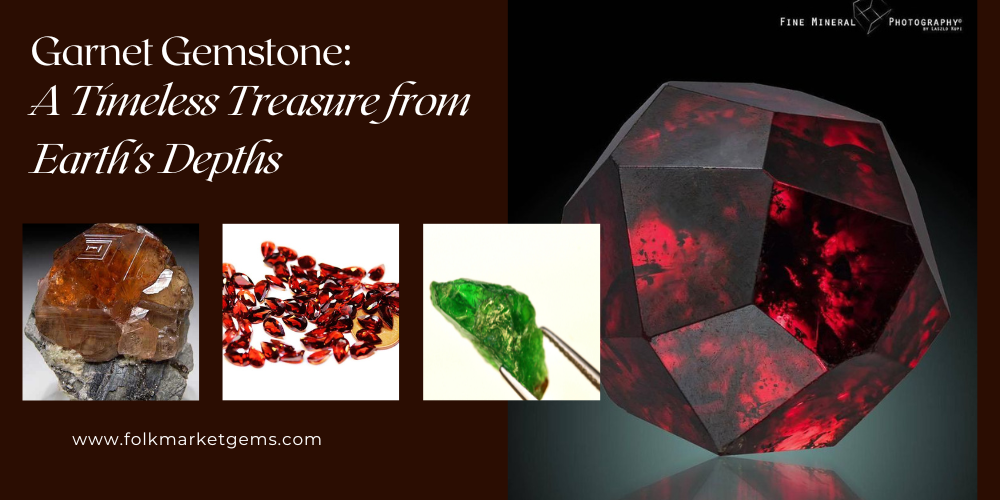Home
Know your Birthstones | Birthstones for Each Month
Exploring the Colorful World of Garnet Gemstones: Varieties and Meanings

Exploring the Colorful World of Garnet Gemstones: Varieties and Meanings
Meaning of Garnet
The word “Garnet” is derived from the Middle English word “gernet” which means “Dark Red.” It also comes from the Old French word “grenate” and the Latin word “granatus” which means “grain or seed.” This is in reference to “ponum granatum” which means pomegranate because small red garnet stones resemble red seeds of pomegranate in colour, size and shape. Garnet is also a symbol of passion and love.
Garnet Crystal Structure
Crystal system of garnet is isometric. Garnets belong to the category of nesosilicates. Their general formula is X3Y2(SiO4)3 where X is a divalent cation (Ca2+, Mg2+, Fe2+, Mg2+) and Y is a trivalent cation (Al3+, Fe3+, Mn3+ , V3+ or Cr3+) arranged in tetrahedral or octahedral framework along with [SiO4]4-
Garnets occur in the following crystal habits:
- Rhombic Dodecahedron
- Cubic
- Trapezohedron
- Hexoctahedral
Garnet Stone Properties/ Chemical/ Technical Properties of Garnet Gemstone
Garnet is a prominent and well-known gemstone which owns many chemical and physical properties like colour, specific chemical composition, streak, diaphaneity, luster etc. which are listed below:
|
Chemical Formula |
X3Y2(SiO4)3 Where X is Ca2+, Mg2+, Fe2+ or Mg2+ Y is Al3+, Fe3+ , Mn3+ ,V3+ or Cr3+ |
|
Colour |
Typically red from rust coloured to deep violet red but can also be white, pink, yellow, orange, green, brown, purple, black or blue |
|
Hardness |
6.5 to 7.5 on the Mohs Hardness Scale |
|
Refractive Index |
1.72-1.94 |
|
Streak |
White |
|
Crystal System |
Isometric |
|
Habit |
Rhombic dodecahedron Cubic Trapezohedron Hexoctahedral Rounded grains, massive granular |
|
Luster |
Vitreous to resinous |
|
Cleavage |
None |
|
Transparency |
Transparent to translucent |
|
Fracture |
Conchoidal to uneven |
|
Tenacity |
Brittle |
|
Group |
Nesosilicates |
|
Rock type |
Metamorphic, igneous and sedimentary rocks, granitic pegmatites |
How Garnet gets its colour?
Garnets are found in almost every colour. Transition metals like iron, manganese, vanadium and chromium enable the garnets to develop different colours.
Most of the garnets are red in colour but they also occur in white, pink, yellow, orange, green, brown, purple and black colours. Blue garnets are rarely found.
In pyrope garnets, chromium or vanadium handles the development of red, pink, purple, blue and green colours. (Orange and yellow colours of spessartine are primarily due to manganese. Purplish red colour in almandine garnets is due to the presence of iron. Fe2+, Fe3+ charge transfer processes cause brown, red and yellow colours in andradite garnets.
Different types of garnets with their colour schemes are given below:
Almandine Fe3Al2(SiO4)3 Deep red to brownish red to purplish red
Pyrope Mg3Al2(SiO4)3 Deep red to nearly black
Spessartine Mn3Al2(SiO4)3 Yellow, orange, pink, red, brown
Grossularite Ca3Al2(SiO4)3 White, yellow, green, pale red, pink, purple, brown, grey
Andradite Ca3Fe2(SiO4)3 Yellow, orange, pink, red, brown, green, black
Uvarovite Ca3Cr2(SiO4)3 Emerald-green
Hydrogrossular Ca3 Al2 (SiO4)3 White, pink, green, to bluish green, brown, grey
History of Garnet Stone
Garnet has been used as a gemstone for about 5000 years since the Bronze age. It was a popular gemstone in Ancient Rome. Garnet has been found in the jewellery of Egyptian burials. Garnet signet rings were worn by the aristocrats to stamp wax seals on important documents. It has also been found in the ancient Greek and Roman ruins. It was placed in Pharaoh's tomb.
Garnet was hailed for its healing powers by the ancient healers. It was used for protection against plague. It was also used to cure the black plague. Garnet was also believed to prevent arguments.
In the past, garnet was used as an amulet and in jewellery. Even the emperors dropped garnet stones into their wine glasses for protection against poison. Ancient people used this stone to honor their Goddess of war, Sekhmet. People thought it to be a symbol of everlasting friendship and life.
The largest garnet mine, the Gore Mountain Mine near North Creek, New York was operated by Barton Mines Corporation in 1878. Today this corporation supplies 90 percent of the world's granite.
Garnet Stone as Birthstone
Garnet is the birthstone of January. According to Tropical Astrology, it is the birthstone of Aquarius and Capricorn. It is a tradition to gift garnet on the second wedding anniversary.
Location of Garnet Stone. Where is it found? Garnet Location around the world
Garnet deposits are found almost all over the world. Metamorphic rocks rich in garnet are found in
- Appalachian Mountains in the Eastern United States
- The Himalayas in Asia
- The Andes in South America
- Skarn deposits of garnet are found in
- The Alps
- The Western United States
Moreover, garnet deposits are found in the following countries:-
- Sri Lanka (Elahera gem field)
- Tanzania (Merelani Hills)
- Madagascar (Bekily)
- Mozambique (Cuamba)
- Namibia (Erongo, S-Kunene)
- Pakistan (Gilgit Baltistan)
- Russia (Ural Mountains)
- India (Rajasthan, Ajmer, Jaipur
- Canada (Laelle)
- Brazil (Bahia, Menas Gerais)
- Nigeria (Komu)
- China (Jinan)
- Kenya (Taita/Taveta district)
What are Geologic and Geographic Occurrences of Garnet?
In Metamorphic Rocks
Garnet is present in those metamorphic rocks whose composition has been changed due to elevated temperature and pressure. It is found in schist, gneiss, amphibolite, eclogite and granulite. This stone indicates medium to high grade metamorphism.
In Igneous Rocks
Garnet occurs as an accessory mineral in igneous rocks which are formed by solidification of magma and in those igneous rocks that have undergone high pressure crystallization. Spessartine is found in granite pegmatites. Some garnets occur in granite igneous rocks.
In Sedimentary Rocks
Garnets are found concentrated in sedimentary rocks. It is easy to mine garnets from sedimentary rocks by mechanical processes.
Skarn Deposits
Garnet occurs in various compositions in skarn deposits. Skarn deposits are found in regions with hydrothermal activity and igneous rocks.
Beach Sands
Garnets occur as erosion resistant stones in some coastal areas.
Garnet Price Guidelines. Value of Garnet Stones
The price of garnet stones depends on size, colour, variety and species of the stone. The price of garnets generally ranges from $500 per carat to $10,000 per carat. Rare garnets like demantoid are more expensive.
Garnet stones are budget friendly and can be used in jewellery at a reasonable cost.
Traditional Meaning and Myths about Garnet Stone
Garnet stones are used in earrings, necklaces and rings because they are easily available and affordable. Today garnets are attractive fashion accessories.
Garnets symbolize passion, fertility, undying love, feminine energy, commitment, trust and strength. One myth about garnet is that it originated with the Greek Goddess of Sunshine (Persephon). Garnets are said to provide safety to the traveller.
It is believed that garnets possess healing properties. Garnets prevent hemorrhages and improve circulation.They are considered to be Chakra healing stones. Many people think that garnets can be used to get rid of negative thoughts. Garnet brings peace and prosperity. It is also called “Gem of Faith”.
So, garnets are beautiful stones and exist in an immense variety. Their sparkling luster makes them much more attractive, and their reasonable prices make them exceptional in the world of gems.




